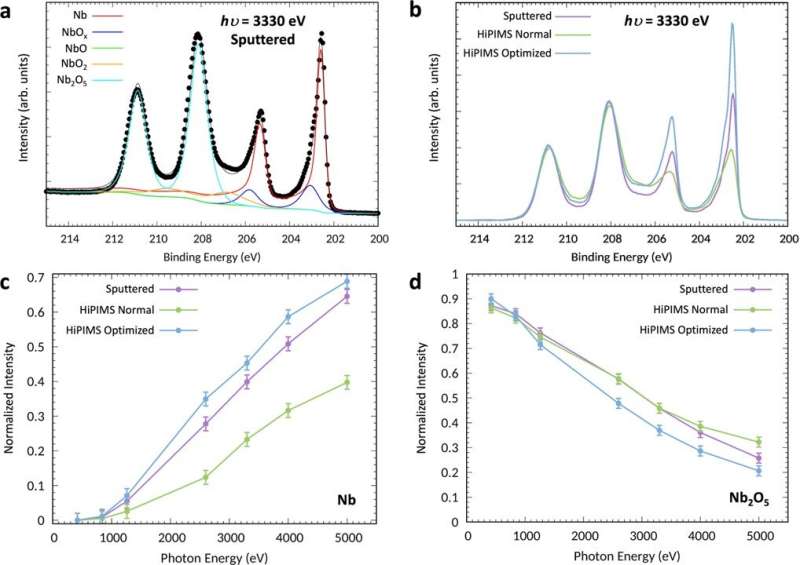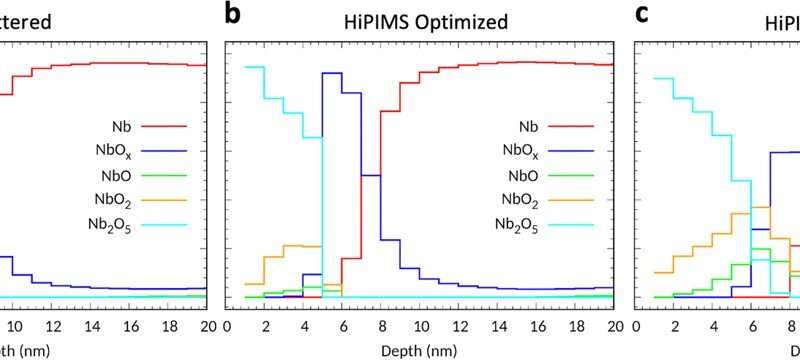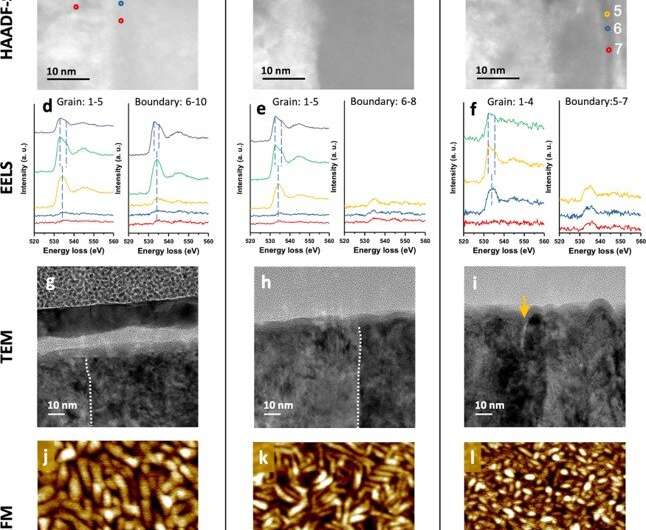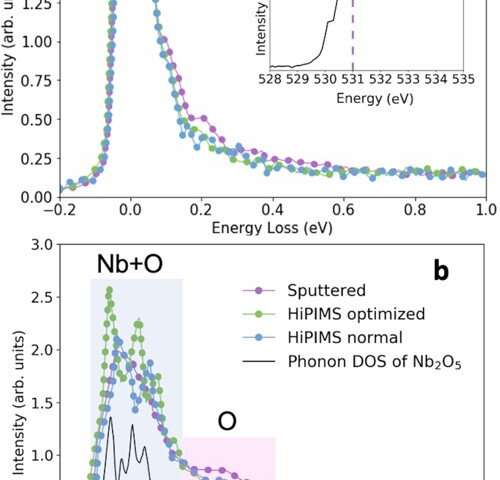Materials for superconducting qubits

The connection between microscopic material properties and qubit coherence are not well understood despite practical evidence that material imperfections present an obstacle to applications of superconducting qubits. In a new report now published on Communications Materials, Anjali Premkumar and a team of scientists in electrical engineering, nanomaterials, physics and angstrom engineering at Princeton University and in Ontario, Canada, combined measurements of transmon qubit relaxation (T1) times with spectroscopy, alongside microscopy of polycrystalline niobium (Nb) films used during qubit development. Based on films deposited via three different techniques, the team revealed correlations between transmon qubit relaxation times and intrinsic film properties, including grain size to enhance oxygen diffusion along grain boundaries, while also increasing the concentration of suboxides near the surface. The residual resistance ratio of the polycrystalline niobium films can be used as a figure of merit to understand qubit lifetimes, and the new approach charts a path for materials-driven improvements of superconducting qubit performance.
Superconducting qubit materials
In this work, Premkumar et al. bridged the gap between qubit performance and microscopic materials, based on a materials-and-device specific investigation of transmon qubits. Superconducting qubit technology is a promising platform for fault-tolerant quantum computation. Scientists have achieved significant enhancements in qubit coherence through new device designs and improved fabrication processes. Nevertheless, the performance improvements have started to plateau since dominant sources of decoherence are not well understood. As a result, research in the subject has surged in order to understand methods of limiting loss mechanisms in qubit materials. Many studies have highlighted the role of surfaces and interfaces during the decoherence of transmon qubits, including proposed mechanisms that involve interactions between the qubit and microscopic objects. To understand the phenomena, a scope of multidisciplinary research is required to investigate the relevant material properties and their connections with qubit performance. Premkumar et al. used spatially resolved x-ray spectroscopy and microscopy to characterize the structural and electronic properties of niobium thin films used in transmon qubit devices. The team detailed the mechanisms underlying the observed microscopic features to resistance and relaxation times. The results form a critical step to connect precise materials properties with microscopic models to improve qubit performance.

Qubit design and performance
The team performed qubit characterization on transmon qubits that are typically widely used for quantum computing and quantum simulation. The transmon qubit design includes a Josephson-junction with a thin aluminum oxide barrier between the superconducting wires shunted by a large capacitor to form a coherent qubit. Scientists can control the transmons in a circuit quantum electrodynamics platform and measure the monitoring transmission at the resonator frequency, as a function of qubit state. During the study, Premkumar et al. used three different deposition methods to deposit the niobium film and fabricate the transmon devices. First, they deposited the materials on sapphire substrates and used direct current sputter deposition for superconducting qubit fabrication. They then used two other methods including high-power impulse magnetron sputtering (HiPIMS) and optimized the technique to improve the degree of ionization and develop denser films. The scientists then characterized the dependence of qubit performance on deposition techniques using relaxation measurements (T1). The results showed a clear statistical difference between the three deposition techniques, where the sputtered niobium consistently performed the best, followed by the optimized HiPIMS method and then the normal HiPIMS method. The team used a range of characterization methods to study the films and understand the possible microscopic origins of the coherence differences.
-

Depth profiles of the different oxidation states of Nb. The profiles for the sputtered (a), HiPIMS optimized (b), and HiPIMS normal (c) Nb films were reconstructed from PES data using a maximum-entropy method algorithm. Each film shows a surface layer of a few nm of Nb2O5, a transition layer with varying concentrations of different suboxides, and the Nb metal bulk. In particular, the HiPIMS normal film shows significant concentrations of NbO and NbO2 in the transition layer and deeper penetration of NbOx into the metal. Credit: Communications Materials, 10.1038/s43246-021-00174-7
-
![Materials for superconducting qubits]()
Resonant inelastic X-ray scattering (RIXS) spectra measured for the Nb films. a RIXS measurements at the oxygen K-edge resonance for an incident energy of 531 eV. The inset shows the O-K absorption spectrum of the sputtered film with a vertical dashed line at the resonance. b Close-up view of the RIXS spectra after subtraction of the elastic line, with the phonon density of states (DOS) calculated for Nb2O5 from45. The overall scaling factor of the DOS was chosen to aid visualization. The DOS was reported to arise from both niobium and oxygen up to ≈70 meV, and mostly from oxygen at higher energies, as represented by the blue and pink bands, respectively. The lower intensity at higher energies for the HiPIMS films indicates a larger concentration of oxygen vacancies. Credit: Communications Materials, 10.1038/s43246-021-00174-7
Understanding the surface material
To understand the surface oxides on the three types of Nb films, Premkumar et al. used a combination of methods such as soft and hard x-ray photoemission spectroscopy and resonant inelastic x-ray scattering. All three film types showed niobium pentoxide (Nb2O5) to be the main constituent. The sputtered film contained the sharpest oxide-metal interface, followed by the HiPIMS optimized method and the HiPIMS-normal film deposition technique. The scientists also used resonant inelastic x-ray scattering to achieve sensitivity to low-energy excitations of the electronic structure. They then correlated the surface oxide findings with surface morphology and grain size using transmission electron microscopy, electron-energy loss spectra and atomic force microscopy measurements for all three types of Nb films. The near-surface morphology of the HiPIMS-normal film was visibly different, where the oxide layer adhered to lower grains. The electron-energy loss spectra provided an outlook of chemical properties near the surface of the oxide-metal, while transmission electron microscopy highlighted the grain boundaries of each sample and atomic force microscopy indicated further information about the grain morphology and size.

Outlook
In this way, Anjali Premkumar and colleagues noted a clear correlation between the qubit relaxation times (T1) and the characterization of Nb (niobium) films, including the residual resistance ratio, grain size and surface suboxide concentration. The team found the total qubit relaxation time to be the sum of multiple mechanisms; where the Nb films deposited by varied techniques dominated the outcomes. The study therefore established a significant link between the performance of superconducting transmon qubits and materials properties during qubit fabrication. The work investigated the microscopic variations among Nb thin films deposited using three different sputtering methods, to specifically understand the grain size, suboxide integration and penetration at the oxide-metal interface, and suboxide intragrain concentration near the surface. The outcomes of this study form a solid basis to develop physical models that can guide the development of materials for superconducting qubits.
Scientists take step towards quantum supremacy
Anjali Premkumar et al, Microscopic relaxation channels in materials for superconducting qubits, Communications Materials (2021). DOI: 10.1038/s43246-021-00174-7
R. Barends et al, Coherent Josephson qubit suitable for scalable quantum integrated circuits, Physical Review Letters (2013). DOI: 10.1103/PhysRevLett.111.080502
A. Place et al, New material platform for superconducting transmon qubits with coherence times exceeding 0.3 milliseconds, Nature Communications (2021). DOI: 10.1038/s41467-021-22030-5
© 2021 Science X Network
Citation:
Materials for superconducting qubits (2021, September 2)
retrieved 2 September 2021
from https://phys.org/news/2021-09-materials-superconducting-qubits.html
This document is subject to copyright. Apart from any fair dealing for the purpose of private study or research, no
part may be reproduced without the written permission. The content is provided for information purposes only.
For all the latest Science News Click Here
For the latest news and updates, follow us on Google News.


